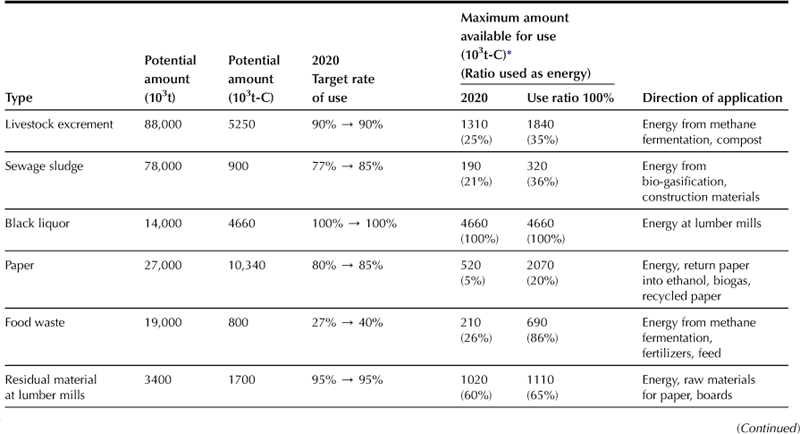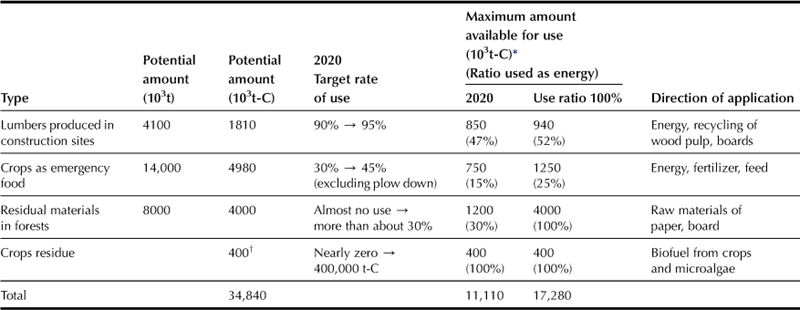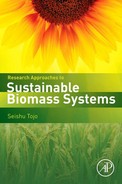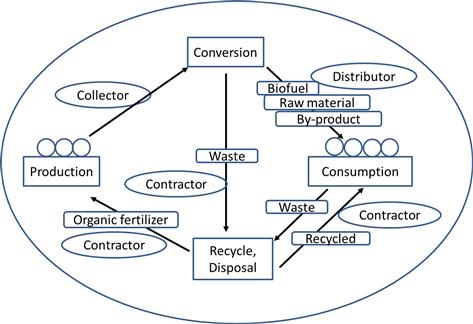Biomass as Local Resource
Toshio Nomiyama, Nobuhide Aihara, Atsushi Chitose, Masaaki Yamada and Seishu Tojo
Abstract
Stressing that a key to the development of biomass utilization is innovation in biomass-related science and technology, this chapter outlines the potential and challenges for biomass utilization with the focus on energy use in a local society. After a brief introduction on the definition of biomass, the characteristics of biomass and the amount available for energy production are described, followed by the discussion on a biomass system that will contribute to establishing a lower-carbon recycling society to mitigate global warming. The advantages and disadvantages of biomass for energy use are enumerated, and the components of the biomass system are illustrated in the framework of the supply chain of biomass material flows. Further, conditions required for the establishment of the optimum biomass system are discussed with emphasis on location-specific characteristics of biomass supply and demand in terms of natural endowments as well as social and economic conditions.
Keywords
Characteristics of biomass as energy source; available amount of biomass; net primary production; supply chain of biomass material flows; location-specific conditions; limited profitability; procurement cost; conversion cost; technological innovation
Chapter Outline
2.1. Definition and Category of Biomass
2.1.2. Characteristics and Categories of Biomass Resources with Emphasis on Energy Use
2.2. Potential Amount of Biomass and Use of Bioenergy
2.2.1. Potential Availability of Biomass in the World
2.2.2. Potential Amount of Biomass and the Amount Available for Use in Japan
2.3.1. Components of a Biomass System
2.1 Definition and Category of Biomass
Toshio Nomiyama and Nobuhide Aihara
2.1.1 Definition of Biomass
Biomass is a collective term applied to the abiotic organic matter and the living plants that are partially integrated into the ecosystem. Plants grow by performing photosynthesis in the presence of sunlight to convert atmospheric carbon dioxide and water in the soil into carbohydrate. Other living organisms use the energy stored in plants to live by degrading carbohydrate into carbon dioxide and water. Plants are important sources of food for human beings and other herbivores in the ecosystem.
In Japan, the roles of biomass as an essential resource in human life including its energy use are emphasized in legal documents. The word “biomass” as a legal term was first mentioned in the “Enforcement Ordinance on the Law Concerning Special Measures to Promote the Use of New Energy”, which was revised in 2002. In the revision, Article 1, Number 1 stipulates that the use of biomass is “to create fuel produced from organic matter derived from animals and plants which can be utilized as energy sources (not including crude oil, petroleum gas, inflammable natural gas, coal, and products manufactured from these resources).” In addition, Numbers 2 and 6, which address the organic matter as “biomass”, stipulate that biomass be used “to gain heat” and “to use it to generate power” as new energy. This interpretation of biomass use is shared by the Basic Law on the Promotion of the Biomass Utilization, which was enacted in 2002. Defined in Article 2, Section 1, biomass is “organic resources derived from animals or plants” excluding fossil resources such as crude oil, petroleum gas, inflammable natural gas and coal. The Basic Law stipulates in Section 2 that biomass be used as raw materials for products (not including indirect uses of biomass as raw materials of products or the use of agricultural and fishery products for originally intended purposes) or as energy sources.”
2.1.2 Characteristics and Categories of Biomass Resources with Emphasis on Energy Use
There are three categories of biomass resources based on their source: (1) waste biomass including organic waste such as livestock excrement and food residues discharged from households and food-related industries; (2) unused biomass composed of inedible parts of agricultural products such as logging residues, rice straw, and rice husk; and (3) resource crops (dedicated energy crops) that can be used to produce bioethanol and biodiesel fuel, such as rapeseed, corn, and rice. The biomass is produced in agriculture as well as forestry and fishery industries as either main crops or waste and unused materials.
Biomass resources are converted into the following six types of end-products: (1) fertilizers and feed; (2) raw materials of chemical products such as amino acids and useful chemical substances; (3) materials such as plastics and resins; (4) fuel such as ethanol, diesel, wood pellets, biogas, and solid fuel; (5) thermal energy; and (6) electric energy. These products are generally used in the following five categories: (1) recycled use; (2) use of products; (3) power generation; (4) use of heat; and (5) use of fuel.
Biomass used for energy is expected to contribute to establishing a lower-carbon recycling society to mitigate global warming. Specifically, biofuel is viewed as a promising renewable energy that contributes to carbon savings as compared with liquid fossil fuel of higher carbon intensity. This is because theoretically biofuel is carbon neutral based on the fact that all biomass carbon has recently been taken from atmospheric carbon in photosynthesis during the plant growth period.
Among renewable energy sources, biomass occupies a unique position due to the following characteristics. First, both historically and geographically, biomass is used almost all over the world; it is available almost anywhere on earth. Second, biomass energy is diverse in terms of both feedstocks and end-use products. A variety of biomass can be converted into different products in the form of solid, liquid, gas, and power. Third, among the many renewable energy sources, only biomass is transportable and storable so that its production can be adjusted to accommodate changes in output demand. Fourth, its use is not limited to energy; fuel is only one option among the many other potential uses. Over human history, biomass has been used for multiple purposes: food, animal feed, fertilizer, fiber, fuel, medicines, and materials for various crafts and buildings. Fifth, waste biomass that has been viewed as inherently detrimental to society can be used as feedstock for energy use.
Although biomass energy has various advantages, it also has disadvantages. First, biomass energy is in general of lower energy intensity than fossil fuel because of its lower bulk density. Second, biomass is less efficient in the conversion into liquid fuel than fossil fuel. The production of liquid biofuel entails greater energy loss in the conversion process. Third, biomass resources are usually distributed in small amounts across wide areas except for high-yielding resource crops. This causes higher feedstock procurement costs (including collection and transportation costs). Fourth, due to the first three characteristics, biofuel production is unlikely to be economically viable using the current level of technology. Fifth, because biomass possesses a feature of possible multiple uses, enhancing biomass energy production would likely lead to unintended repercussions regarding its other uses (e.g. food and animal feeds) that may adversely impact the food supply or biodiversity, causing social and environmental problems.
2.2 Potential Amount of Biomass and Use of Bioenergy
2.2.1 Potential Availability of Biomass in the World
There are abundant amounts of biomass growing on land and in the ocean. The total amount of biomass on land is about 1.8 trillion tons based on dry weight and about 4 billion tons in the ocean. Also, the soil contains biomass of almost equal amount to terrestrial plants. Because the biomass includes food for human consumption and animal feed, estimating only the amount of convertible biomass for energy sources is meaningful and important.
The available amount of biomass for energy and other uses is subject to the net balance between biomass production and self-consumption by living organisms on a flow basis. The flow biomass is usually called primary biomass produced from the stock biomass. Net primary production (NPP) is a widely used indicator to show the net balance; it is defined as the difference between the rate at which the plants in an ecosystem produce biomass and the rate at which they consume some of the resulting biomass for respiration. Cao and Woodward (1998) estimated that global NPP was 57 Pg-C y−1 with 640 Pg-C of carbon stocks in vegetation and 1358 Pg-C of carbon stocks in soil. According to Janzen (2004), atmospheric CO2 enters terrestrial biomass via photosynthesis at a rate of about 120 Pg-C y−1 (gross primary productivity). However, about half of it is immediately released as CO2 by plant respiration, so that the NPP is about 60 Pg-C y−1. Undoubtedly, sustainable biomass utilization is subject to a lower rate than the NPP. In addition to the excessive use of biomass, inadequate use of biomass should be avoided because inappropriate management in biomass use may lead to adverse effects on a local ecosystem such as the degradation of biodiversity and the diminished capacity to provide other environmental services.
Regarding the potential amount of biomass for bioenergy, according to an estimate by the Japan Institute of Energy (2009), the standing stock of waste-based biomass per year in the world is 51 EJ in agriculture, about 47 EJ in livestock farming, and about 40 EJ in forestry, making the total amount about 138 EJ. The waste biomass from cattle manure is about 23 EJ, accounting for the largest proportion in the breakdown, followed by logging waste that is about 22 EJ. By regions, Asia has large potential, accounting for 58% of availability in crop biomass and 47% in livestock biomass.
2.2.2 Potential Amount of Biomass and the Amount Available for Use in Japan
The available quantity of biomass and the target rate of biomass use in 2020 based on its type in Japan estimated by the Ministry of Agriculture, Forestry and Fishery (MAFF), Japan are shown in Table 2.1. This estimated amount of biomass expressed in carbon equivalents is based on the information available in the Basic Plan for the Promotion of Biomass Utilization. Most types of biomass are used for resources and raw materials. Meanwhile, the data in the table indicate slow progress in the use of non-edible biomass such as food waste, inedible parts of agricultural crops, and residual materials from forestry. Table 2.2 summarizes the potential annual bioenergy production in 2020 in Japan. The use of biomass energy in 2020 was predicted by MAFF for converting the potential biomass into energy.
TABLE 2.1
Potential Amount of Biomass and Target Rate of its Use in 2020 by Biomass Type in Japan


∗Maximum amounts available for use are calculated based on an assumption that (1) target use ratio in 2020 and (2) 100% use ratio are all achieved by increasing the uses as energy.
†Crops are target amount of production in 2020.
Source: MAFF (2012). Current status and problems of biomass. Reference in the 9th Meeting of the Biomass Business Strategy Exploration Team of the MAFF.
TABLE 2.2
Target of Bioenergy Production in 2020 in Japan
| 2020 | Use ratio 100% | |
| Gross calorific value | 460 PJ y−1 | 720 PJ y−1 |
| 1. Energy∗ | 13 billion kWh | 22 billion kWh |
| (Electricity to households)† | 2,800,000 households | 4,600,000 households |
| 2. Fuel (crude oil equivalent) | 11,800,000 kL | 18,500,000 kL |
| (Gasoline for automobiles)† | 13,200,000 cars | 20,800,000 cars |
| 3. GHG to be reduced‡ | 40,700,000 t-CO2 | 63,400,000 t-CO2 |
| (GHG emissions in Japan)§ | 3.2% | 5.0% |
∗1 PJ = 25,800 kL (equivalent of crude oil) = 278 million kWh. Available amount to be used as electricity is calculated while taking into account of power generation loss and efficiency of gasification, etc.
†Calculations are based on conditions that electricity consumption per household is 4734 kWh y−1, and the amount of gasoline consumption per automobile is 1000 L y−1.
‡Converted maximum amount available for use (t-C) based on the ratio of atomic/molecular weights of C and CO2.
§The value in the quick report in FY 2010 was 1.256 billion tons.
Source: MAFF (2012). Current status and problems of biomass. Reference in the 9th Meeting of the Biomass Business Strategy Exploration Team of the MAFF.
2.3 Biomass Systems
Atsushi Chitose, Masaaki Yamada, and Seishu Tojo
2.3.1 Components of a Biomass System
When biomass is used as a resource for human activities, the concept of a biomass system should be established (Kitani, 2004). Effective utilization of biomass requires a comprehensive framework that integrates all stages of the supply chain of biomass material flows – i.e. production, collection, transport, conversion, distribution, and consumption – into a well-organized and structured system. The concept of this supply chain is schematically illustrated in Figure 2.1.
In the production stage, identifying the various types of biomass suitable for local geographical and meteorological conditions is required. Biomass can be produced mainly in artificial forest, farm land, lake, and coastal areas. These spaces and fields are located in a continuous area or regions that are linked organically. In the collection and transport stage, biomass will be collected to centralize conversion facilities. The collector and transporter of biomass along with the disposal contractor and the distributor of products in the distribution stage play leading roles as linkers of respective space and facility.
In the conversion stage, the conversion facilities of biomass to biofuel and other end-use products, which are important components of the biomass system, play central roles in supplying energy and industrial raw materials to consumers. The waste generated in the conversion process should be disposed of by returning it to the original fields in a manner in harmony with the local ecosystem. Biomass supply will be maintained by keeping the fields adequately in the ecosystem because the production and use of biomass fundamentally rely on the function of nature everywhere.
In the consumption stage, the consumer of biofuel and other end-products performs the anchor role in the biomass system. The biomass system would be managed under the governing regulations and rules, and a well-managed system coordinates various fields, spaces, facilities, stakeholders and agents for enhancing local industries without imparting additional environmental loads by cooperating with various local organizations through the establishment of an effective social network.
2.3.2 Prerequisites for a Biomass System
The construction of an optimal biomass system requires thorough consideration from a holistic point of view with attention to the following location-specific characteristics in terms of natural endowments as well as social and economic conditions.
First, the biomass system is subject to the biomass feedstock available in both type and volume. Thus, the optimal biomass system would depend on the natural resources in a particular region. The optimal combination of potential biomass resources in use is determined by climate, geography, water, land resources, and other natural conditions. Second, the biomass system is conditional on the stage of economic development. The promotion of biomass utilization is expected to generate social and economic benefits in addition to its contribution to the reduction of GHG emissions. However, these expected benefits will vary according to local social and economic conditions with different system components. Also, the stage of economic development governs the conditions surrounding the biomass supply chain. Generally social infrastructure such as roads, water supply, and electric distribution is better provided in higher-income than in lower-income regions. Third, the biomass system may be subject to social, cultural, and institutional rules including formal laws, acts, other legal regulations and codes, as well as informal constraints such as local customs, norms and cultural beliefs. The adoption and diffusion of new biomass use to a larger extent may require institutional innovation that will induce a society to establish an appropriate social system to facilitate an effective use of local biomass resources.
Given these location-specific conditions, the optimal technology applied to the biomass system can be determined. Technology is associated with all stages of the biomass supply chain, spanning production, collection, transport, conversion, and distribution. Specifically, the biomass system requires the development of an optimal set of bio-related technologies that adapts local conditions in the production and conversion stages. Furthermore, because the enhancement of biomass utilization may bring about adverse environmental and social impacts and consequences, the biomass system should suffice the environmental assessment and other evaluations in the planning stage.
It is clear that the construction of a biomass system requires a thorough assessment in all stages of the biomass supply chain from various points of view. In principle, the sustainable operation of the biomass system should satisfy the conditions such that it is economically viable, environment friendly, and socially acceptable. More specifically, the prerequisites of the biomass system are: (a) not to compete with food production; (b) to produce no additional environmental load; (c) to contribute to the construction of a lower-carbon society; (d) to be adaptable to a local society; (e) to be managed throughout the biomass system; and (f) to be economically viable from a societal point of view.
With these prerequisites, the priority of using biomass resources may differ among regions; however, it seems legitimate that, in practice, the priority should be assigned in the following order: first on food, second on the material use for higher-value products that will contribute more to increases in rural income, third on animal feed or fertilizer, and perhaps last on fuel. The main reason that fuel production would be given the lowest priority in biomass utilization is its low profitability in a commercial operation. With the current state of technology, biofuel cannot compete with fossil fuel in profitability with only a few exceptions such as the case of sugar cane-based ethanol in Brazil. This implies that economic viability is an important prerequisite for the development of biofuel production.
Although in practice there are various challenges for the adoption and development of biomass utilization in society, the Japanese experience suggests that, currently, limited profitability and inadequate legal provision are recognized as the major bottleneck. The generation of new industries associated with biomass use has been impeded by the current legislative framework that is likely to discourage the new entry of agricultural and forestry industries into the energy business. Moreover, the lack of evidence of economic viability for ongoing biomass projects casts doubts on the sustainability of the biomass system without government subsidies. Because lower profitability is more likely to be viewed as a serious problem, the essential factors underlying lower profitability with focus on the case of biofuel production will be briefly discussed in the following paragraphs.
Needless to say, profit is positive if the unit price of the produced biofuel is higher than its unit production cost. On the demand side, the biofuel price is influenced heavily by the prices of other substitutable fuels such as oil as well as by government support. However, the dependence of government support in the form of subsidies and tax exemption will not last long; thus, an optimal biomass system that functions without government support in the long run is needed.
On the supply side, the production cost roughly consists of the feedstock procurement cost and the conversion cost. The procurement cost involves the stages of procurement of feedstock for producing, collecting, and transporting it to the processing sites. The procurement cost relies on production environments of feedstock such as climate and geographic conditions, production technology (e.g. genetics and farming practices), infrastructure (e.g. irrigation facilities and roads), as well as social institutions (e.g. land tenure institutions). The conversion cost that is composed primarily of the cost of conversion from feedstock to biofuel is subject to technology (e.g. fermentation and bioengineering) and infrastructure (e.g. water supply and electricity). Because both types of costs involve the transportation of raw materials or final products, these costs are influenced by the accessibility to markets as long as biofuel is produced on a commercial basis.
The two costs are more likely to have a tradeoff relationship; a higher feedstock procurement cost coincides with a lower conversion cost, and vice versa. The first-generation biofuel feedstocks such as corn and rapeseed are viewed as an example of the case of a higher procurement cost and a lower conversion cost. Conversely, the use of cellulose such as rice straw or other second-generation biofuel feedstocks is characterized by a lower procurement cost and a higher conversion cost, given the present state of technology. From an economic point of view, the production of first-generation biofuel is subject primarily to types of feedstocks and their production environments. In fact, given current technology, the cost of feedstock constitutes more than half of biofuel production cost (World Bank, 2007). In contrast, the production of the second-generation biofuel relies mostly on the levels of bioengineering technology that plays a critical role in the conversion process. This implies that the key to attaining economic viability of the first-generation biofuel production is a rational choice of feedstocks coupled with the development of higher biomass cultivars under favorable production environments, whereas the second-generation biofuel production relies on technological innovation in the conversion process for practical use.
Because technological innovation in biology and bioengineering will lower either the procurement or the conversion cost, it is the key to the success of the biomass system. The subsequent chapters of this book discuss the current advancements in biomass-related science and technology that will contribute to the construction of an ideal biomass system to assist in ultimately developing a lower-carbon society. However, it should also be kept in mind that identifying the optimal combination of technologies associated with all stages of the biomass supply chain, subject to location-specific characteristics in terms of both natural endowments and socio-economic conditions, is of equal importance to the success of the biomass system.
References
1. Cao M, Woodward FI. Net primary and ecosystem production and carbon stocks of terrestrial ecosystems and their responses to climate change. Global Change Biology. 1998;4:185–198.
2. Janzen HH. Carbon cycling in earth systems; a soil science perspective. Agriculture, Ecosystems and Environment. 2004;104:399–417.
3. Japan Institute of Energy. Biomass handbook. 2nd ed. Tokyo: Ohmusha [in Japanese]; 2009.
4. Kitani O. Biomass – Bioresources and environment. Tokyo: Coronasha; 2004.
5. Ministry of Agriculture, Forestry, and Fisheries (MAFF), Japan (2012). Current status and problems of biomass. Reference material distributed in the 9th Meeting of the Biomass Business Strategy Exploration Team of MAFF [in Japanese].
6. World Bank. World Development Report 2008: Agriculture for development. (Chapter 2) Washington, DC: World Bank; 2007.

